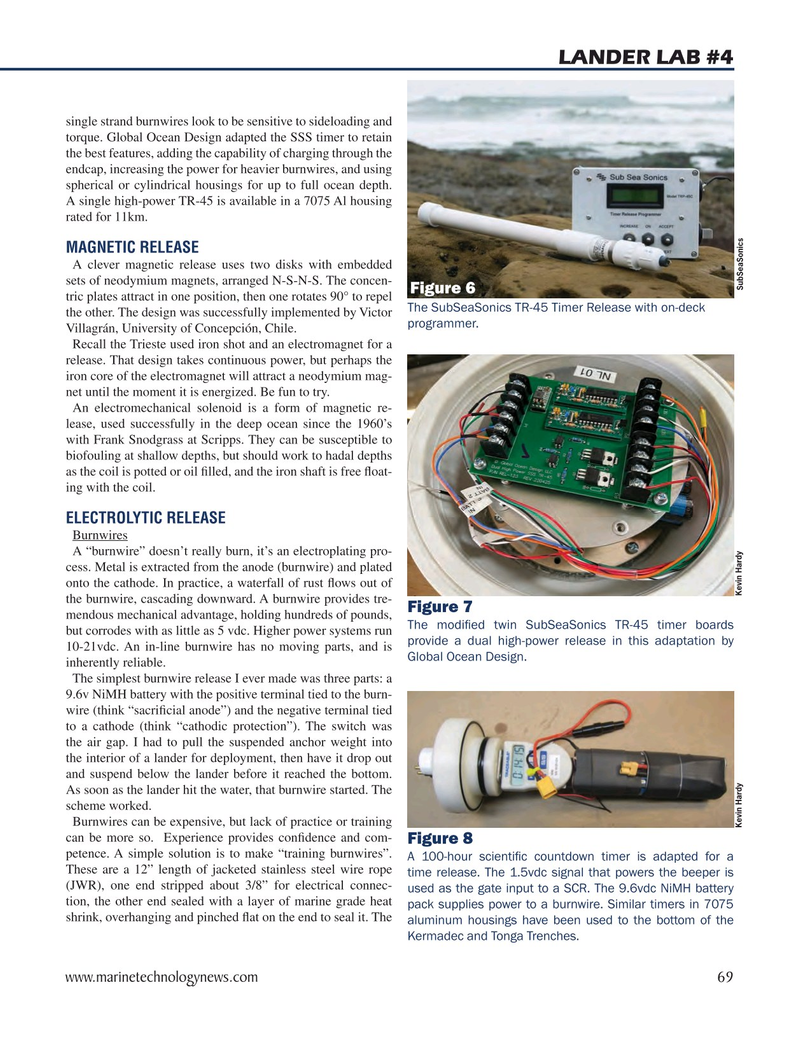
Page 69: of Marine Technology Magazine (September 2022)
Read this page in Pdf, Flash or Html5 edition of September 2022 Marine Technology Magazine
LANDER LAB #4 single strand burnwires look to be sensitive to sideloading and torque. Global Ocean Design adapted the SSS timer to retain the best features, adding the capability of charging through the endcap, increasing the power for heavier burnwires, and using spherical or cylindrical housings for up to full ocean depth.
A single high-power TR-45 is available in a 7075 Al housing rated for 11km.
MAGNETIC RELEASE
A clever magnetic release uses two disks with embedded sets of neodymium magnets, arranged N-S-N-S. The concen-
SubSeaSonics
Figure 6 tric plates attract in one position, then one rotates 90° to repel the other. The design was successfully implemented by Victor The SubSeaSonics TR-45 Timer Release with on-deck programmer.
Villagrán, University of Concepción, Chile.
Recall the Trieste used iron shot and an electromagnet for a release. That design takes continuous power, but perhaps the iron core of the electromagnet will attract a neodymium mag- net until the moment it is energized. Be fun to try.
An electromechanical solenoid is a form of magnetic re- lease, used successfully in the deep ocean since the 1960’s with Frank Snodgrass at Scripps. They can be susceptible to biofouling at shallow depths, but should work to hadal depths as the coil is potted or oil ? lled, and the iron shaft is free ? oat- ing with the coil.
ELECTROLYTIC RELEASE
Burnwires
A “burnwire” doesn’t really burn, it’s an electroplating pro- cess. Metal is extracted from the anode (burnwire) and plated onto the cathode. In practice, a waterfall of rust ? ows out of the burnwire, cascading downward. A burnwire provides tre-
Figure 7 mendous mechanical advantage, holding hundreds of pounds,
The modi? ed twin SubSeaSonics TR-45 timer boards but corrodes with as little as 5 vdc. Higher power systems run 10-21vdc. An in-line burnwire has no moving parts, and is provide a dual high-power release in this adaptation by
Global Ocean Design. inherently reliable.
The simplest burnwire release I ever made was three parts: a 9.6v NiMH battery with the positive terminal tied to the burn- wire (think “sacri? cial anode”) and the negative terminal tied to a cathode (think “cathodic protection”). The switch was the air gap. I had to pull the suspended anchor weight into the interior of a lander for deployment, then have it drop out and suspend below the lander before it reached the bottom.
As soon as the lander hit the water, that burnwire started. The scheme worked.
Burnwires can be expensive, but lack of practice or training
Kevin Hardy Kevin Hardy can be more so. Experience provides con? dence and com-
Figure 8 petence. A simple solution is to make “training burnwires”. A 100-hour scienti? c countdown timer is adapted for a
These are a 12” length of jacketed stainless steel wire rope time release. The 1.5vdc signal that powers the beeper is (JWR), one end stripped about 3/8” for electrical connec- used as the gate input to a SCR. The 9.6vdc NiMH battery tion, the other end sealed with a layer of marine grade heat pack supplies power to a burnwire. Similar timers in 7075 shrink, overhanging and pinched ? at on the end to seal it. The aluminum housings have been used to the bottom of the
Kermadec and Tonga Trenches. www.marinetechnologynews.com 69
MTR #7 (66-79).indd 69 9/28/2022 7:13:53 PM

 68
68

 70
70
